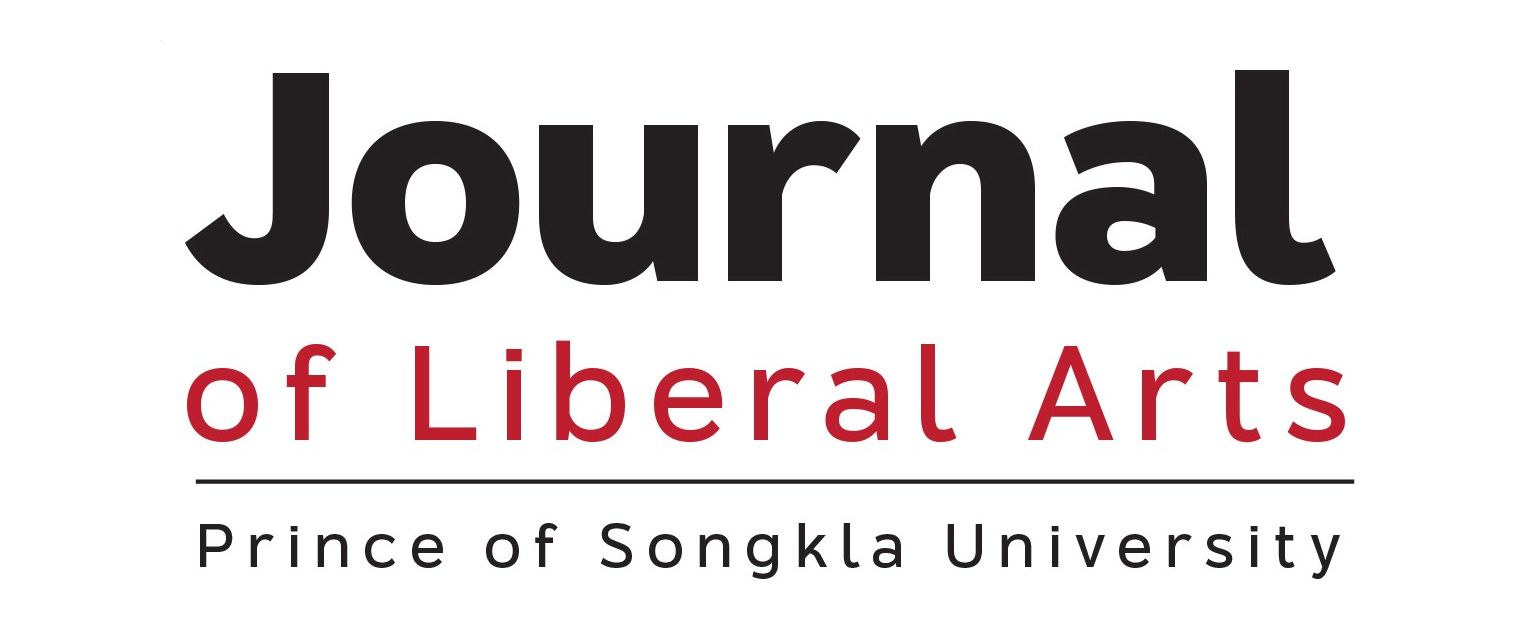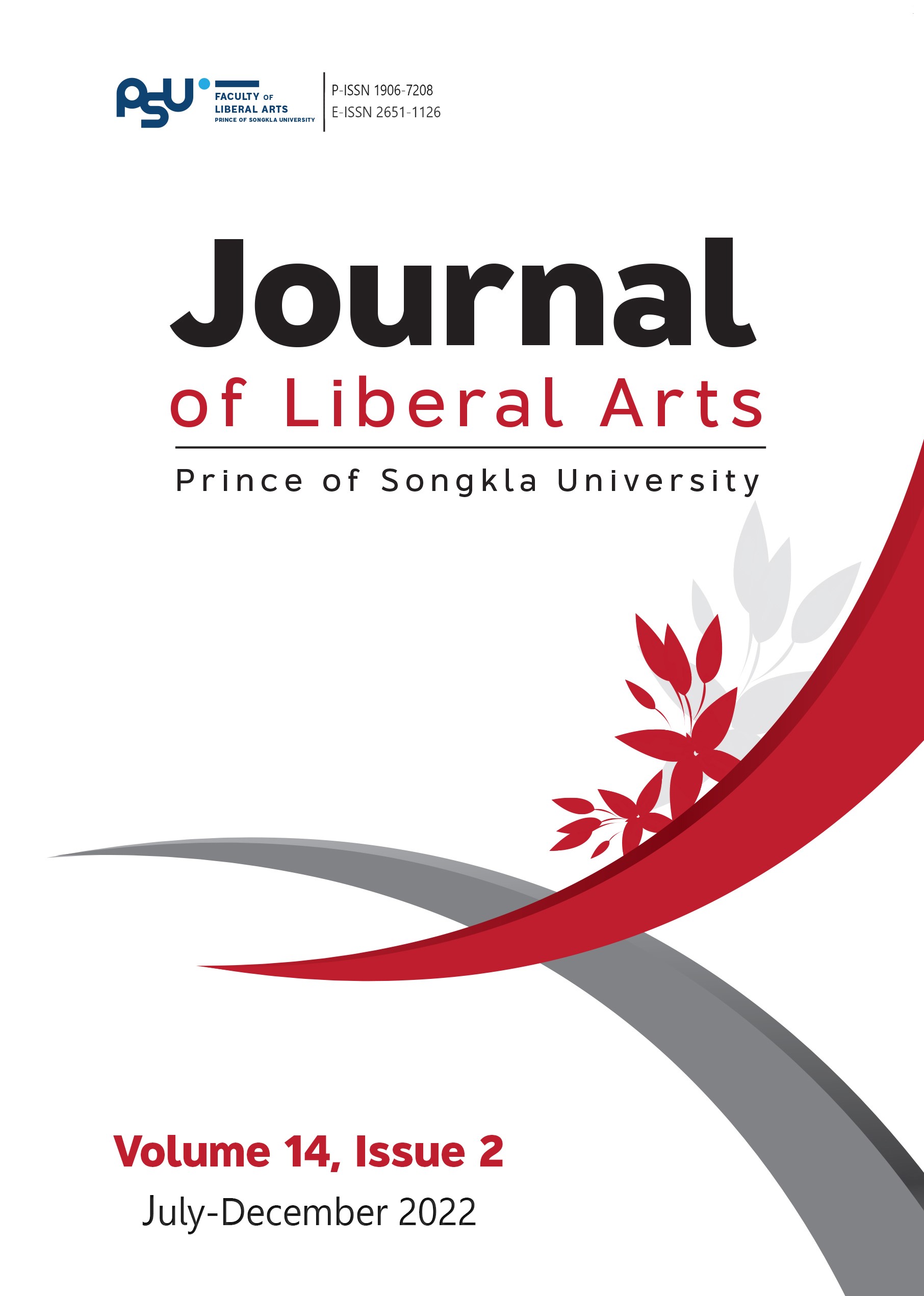วรรณยุกต์สนธิในภาษาลาหู่แดง
DOI:
https://doi.org/10.14456/jlapsu.2022.18คำสำคัญ:
วรรณยุกต์ , วรรณยุกต์สนธิ, ภาษาลาหู่แดง , กลสัทศาสตร์บทคัดย่อ
จุดประสงค์ของงานวิจัยนี้คือตรวจสอบว่ามีวรรณยุกต์สนธิในภาษาลาหู่แดงหรือไม่ ภาษาลาหู่แดงมีเสียงวรรณยุกต์ 7 หน่วยเสียง เป็นสำเนียงหนึ่งของภาษาลาหู่ที่อยู่ในกลุ่มภาษาโลโล-พม่าของตระกูลจีน-ทิเบต (Matisoff, 2003) วรรณยุกต์สนธิคือวรรณยุกต์แปรรูปอย่างหนึ่ง โดยที่หน่วยเสียงวรรณยุกต์ดั้งเดิมเปลี่ยนไปเป็นอีกหน่วยเสียงวรรณยุกต์เนื่องจากเสียงวรรณยุกต์หรือหน่วยคำที่อยู่ใกล้ ปรากฎการณ์นี้เกิดขึ้นในภาษาที่ใช้เสียงวรรณยุกต์บางภาษาเท่านั้น ในงานวิจัยนี้ เจ้าของภาษาลาหู่แดงห้าคนจากอำเภอเชียงดาว จังหวัดเชียงใหม่ ประเทศไทย ได้อ่านรายการคำศัพท์ที่ออก แบบมาเพื่อทดสอบวรรณยุกต์สนธิ ในห้องอัดแบบกันเสียง หลังจากนั้นนักวิจัยได้ถอดเสียงและทำการวิเคราะห์ทางเสียง โดยเปรียบเทียบข้อมูล อาทิ รูปแบบของความถี่มูลฐาน และความยาวของเสียงสระ ของเสียงวรรณยุกต์ดั้งเดิมและเสียงวรรณยุกต์ในบริบทที่อาจทำให้เกิดวรรณยุกต์สนธิ ผลของงานวิจัยแสดงว่าวรรณยุกต์สนธิเกิดในบริบทสามบริบท คือ คำประสม การเรียกชื่อสี และคำกริยาการีต เช่น คำว่า ให้กิน เป็นกริยาการีต และ คำว่า กิน เป็นสกรรมกริยา ในการสร้างคำประสม วรรณยุกต์เปลี่ยนรูปจากเสียงกลางเป็นเสียงสูง ในการเรียกชื่อสี เปลี่ยนจากเสียงกลางเป็นสูงขึ้น และในการสร้างกริยาการีต เปลี่ยนจากเสียงสูงเป็นต่ำ ผลวิจัยนี้ยืนยันว่ามีวรรณยุกต์สนธิในภาษาลาหู่แดงและภาษาลาหู่สำเนียงแดงและสำเนียงดำมีความคล้ายคลึงกัน
เอกสารอ้างอิง
Abramson, A.S. (1979). The coaticulation of tones: An acoustic study of Thai. In Kullavanijaya, K. Tingsabadh & T. Luangthongkum (Eds.), Studies of Tai and Man-Khmer phonetics in honour of Eugenie J. A. Henderson (pp. 1-9). Chulalongkorn University Press.
Bradley, D. (1979). Lahu Dialects. Australian National University Press.
Bradley. D. (2003). Lisu. In G. Thurgood & R. J. LaPolla (Eds.), The Sino-Tibetan languages (pp. 222-235). Routledge.
Boersma, P., & Weenink, D. (2022). Praat: Doing phonetics by computer [Computer program]. Version 6.2.23, retrieved 8 October 2022 from http://www.praat.org/
Chen, M. Y. (2000). Tone sandhi: Patterns across Chinese dialects (Vol. 92). Cambridge University Press.
Chao, Y. R. (1930). A system of tone-letters. Le Maitre Phonétique, 45, 24-27.
Ethnologue. (2018, April). Lahu. https://www.ethnologue.com/ language/lhu.
Gandour, J., Potisuk, S., Dechongkit, S., & Ponglorpisit, S. (1992). Tonal coarticulation in Thai disyllabic utterances: A preliminary study. Linguistics of the Tibeto-Burman Area, 15(1), 93-110.
Hansson, I-L. (2003). Akha. In G. Thurgood & R. J. LaPolla (Eds.), The Sino-Tibetan languages (pp. 885-901). Routledge.
Inter Mountain People’s Education and Culture in Thailand Association. (2015). In Minutes of IMPECT committee meeting, November 24, 2015. IMPECT Office.
Jangjamras, J., Wayland, R., & Chen, S. (2019). Acoustic analysis of Lahu Nyi tone system. In S. Calhoun, P. Escudero, M. Tabain & P. Warren (Eds.), Proceedings of the 19th International Congress of Phonetic Sciences, Melbourne, Australia 2019 (pp. 3882-3886). Australasian Speech Science and Technology Association Inc.
Kirby, J., & Brunelle, M. (2017). Southeast Asian tone in areal perspective. In R. Hickey (Ed.), The Cambridge handbook of areal linguistics (p. I). Cambridge University Press.
Ladyxoxo.com. (n.d.). Carrying boy [Photograph]. https://www.ladyxoxo.com/upload/img/dc/7e313cadc.jpg
Lewis, P. (1986). Lahu-English-Thai dictionary. Darnsutha Press.
Matisoff, J. A. (2003). Lahu. In G. Thurgood & R.J. LaPolla (Eds.), The Sino-Tibetan languages (pp. 918-931). Routledge.
Matisoff, James A. (2006). English-Lahu lexicon. University of California Press.
Potisuk, S., Gandour, J., & Harper, M. (1997). Contextual variations in trisyllabic sequences of Thai tones. Phonetica, 54(1), 22-42
Rose, P. (1990). Acoustics and phonology of complex tone sandhi: An analysis of disyllabic lexical tone sandhi in the Zhenhai variety of Wu Chinese. Phonetica, 4(7), 1-35.
Sirisai, S. (1986). The phonological description of Lahu Nyi language spoken in Chayi village, Pa-tung sub-district Meachan district, Chiengrai province. [Unpublished master’s thesis]. Mahidol University.
Tu, J. Y., & Chien, Y. F. (2021). The role of categorical perception and acoustic details in the processing of Mandarin tonal alternations in contexts: An eye-tracking study. Frontiers in Psychology, 12, 1-14.
Waite, G. (n.d.). Carrying [Photograph]. Pinterest.https://www.pinterest.com/pin/645070346610003737/.jpg
Walker, A. R. (1980). The production and use of opium in the northern Thai uplands: An introduction. Contemporary Southeast Asia, 2(2), 135–154. http://www.jstor.org/stable/25797612
Xu, Y. (1997). Contextual tonal variations in Mandarin. Journal of Phonetics, 25(1), 61-83.
Xu, Y. (2013). Prosody Pro. http://www.homepages.ucl.ac.uk/~uclyyix/ProsodyPro/
Zhang, J. (2014). Tones, tonal phonology, and tone sandhi. In C.-T.J. Huang, Y.-H.A. Li, & A. Simpson (Eds.), Chinese linguistics (pp. 443–464). John Wiley & Sons.
Zhang, J., & Lai, Y.-W. (2010). Testing the role of phonetic knowledge in Mandarin tone sandhi. Phonology, 27, 153-201.
Zhang, J., & Liu, J. (2011). Tone sandhi and tonal coarticulation in Tianjin Chinese. Phonetica, 68, 161-191.
Zhu, X., & Wang, C. (2015). Tone. In S-Y.W Wang & C. Sun (Eds.), The Oxford handbook of Chinese linguistics (pp. 503 -516). Oxford University Press.
ดาวน์โหลด
เผยแพร่แล้ว
รูปแบบการอ้างอิง
ฉบับ
ประเภทบทความ
สัญญาอนุญาต
ลิขสิทธิ์ (c) 2022 ๋Jirapat Jangjamras, Ratree Wayland

อนุญาตภายใต้เงื่อนไข Creative Commons Attribution-NonCommercial-NoDerivatives 4.0 International License.
ลิขสิทธิ์บทความเป็นของผู้เขียน แต่วารสารศิลปศาสตร์ มหาวิทยาลัยสงขลานครินทร์ ขอสงวนสิทธิ์ในการเป็นผู้ตีพิมพ์เผยแพร่เป็นครั้งแรก






